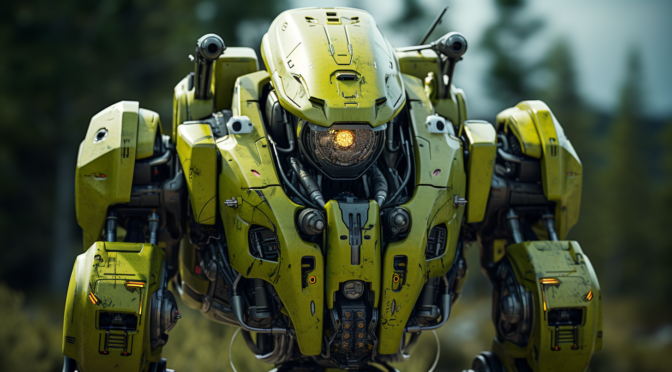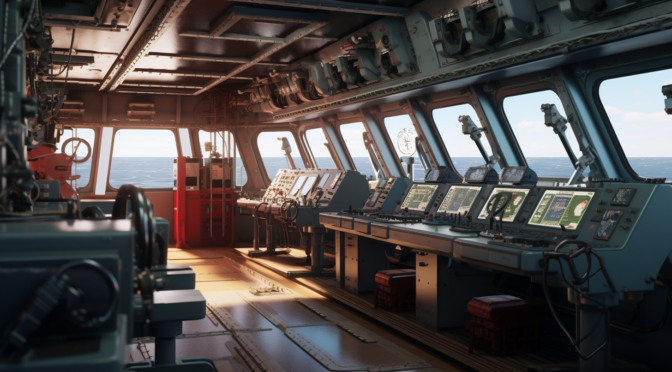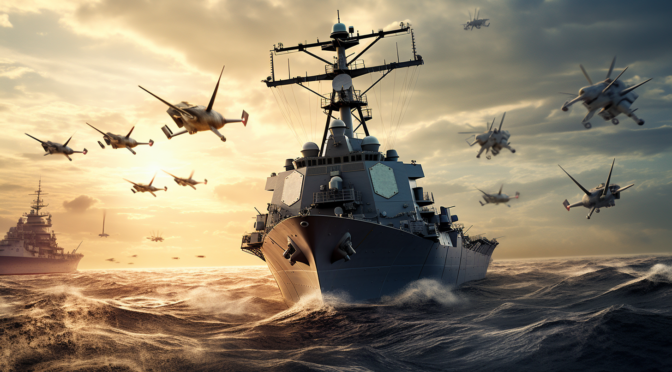By Daniel Goff
Shakedown Cruise
On a wet and cold winter night Col Marcus, the 26 MEU commander, and SgtMaj Martin arrive at the Johns Hopkins Applied Physics Lab for a special assignment.
“It is going to snow later,” said Col Marcus as the wind-swept rain brushed his face.
Seemingly unaffected by the icy rain, SgtMaj Martin asked, “Sir, do you know why General Trimble has given us this assignment?”
“He saved my ass in Venezuela…he said this is my payback,” replied Col Marcus with a hint of apprehension.
“So, this is going to be bad,” said SgtMaj Martin flatly.
The Colonel and SgtMaj presented their paperwork and guards led the pair into a small office deep in the lab where Dr. Jack Droz and Dr. Mary Wollstone eagerly awaited.
Dr. Wollstone stood and greeted Col Marcus and SgtMaj Martin as they entered the room.
“Greetings Col Marcus and SgtMaj Martin, this is my colleague Dr. Droz. He is the lead for the OX-XO program. We are incredibly pleased that General Trimble agreed to allow your MEU to be the test case for OX-XO,” said Dr. Wollstone with excitement.
Dr. Droz shook SgtMaj Martin’s hand, and when he gripped the Colonel’s hand, he realized just how big the former linebacker was. Col Marcus played football and rugby for the Midshipmen, and he looked the part, albeit with rounded shoulders and graying hair. Col Marcus looked like a brute, but his eyes revealed his character. They were keen and compassionate and filled with kindness.
Dr. Droz stepped back from the Marines, and bursting with enthusiasm, he blurted, “We are so happy that you will be taking OX-XO on your upcoming deployment to give our OX program real-world operational data. Our data scientists have been making final adjustments and we believe the OX-XO will greatly enhance your operational effectiveness and mission readiness.”
Col Marcus interrupted, “I am sorry but what is OX-XO?”
Dr. Wollstone looked confused and annoyed and then calmly stated, “Our OX program stands for Operational Exoskeleton, and your specific version is the Executive Officer. We realize there was a last-minute change with your MEU’s assignment, and given the lack of operational shipping, your MEU will serve in the Mediterranean and Pacific. General Trimble agreed to have your MEU take the program for its ‘shakedown cruise,’ even over the ACMC’s objections. General Lynch thought more testing was needed but the SecNav convinced General Trimble to okay the test run.”
“I appreciate the background, but we only found out about the tasker earlier this week and we do not have access to the files detailing what we have been assigned,” said Col Marcus in a measured tone.
“Oh, that is most unfortunate, but it should not be an issue. You see, our AI system at the service and fleet level has been working extremely well, and the Navy and Marine Corps have decided to employ it in a mobile configuration for testing and evaluation. Meet OX-XO, your new Executive Officer.” Dr. Wollstone was pleased with her pronouncement, and with a deft swiping of the keys on her tablet, a humanlike robot entered the room.
The OX-XO was a few inches shorter than Col Marcus, and he thought it resembled an odd combination of old classic science fiction movies, the Terminator without all the ominous features, and Start Wars’ C-3PO. Boston Dynamics created the robot in conjunction with MIT and Johns Hopkins. It was undoubtedly state-of-the-art and far superior to the robots on the market doing heavy manufacturing and jobs deemed dangerous to humans. Composite paneling covered the internals and only the major joints revealed the machinery needed for the robot to move. Its head was completely enclosed in metal, and its lifeless yellow eyes turned to examine the Colonel. The entire robot was painted in a flat green with hints of steel, carbon fiber, and aluminum in various critical places.
“Does it talk, or does it link with our command computer system?” asked Col Marcus as he inspected the OX-XO’s shoulder joint.
“I can do both. However, my programming directs that I interact as humans do whenever possible,” said the OX-XO in a flat, metallic voice.
Col Marcus thought that he heard a slight growl come from SgtMaj Martin and asked Dr. Wollstone and Dr. Droz a series of questions about the program requirements needed and logistical concerns about bringing a robot aboard ship. Over the next couple of hours, the two scientists answered the Marines’ questions, assuring them that all the technical requirements would be met at the Johns Hopkins Applied Physics Laboratory. When SgtMaj Martin asked if the MEU entered a conflict, would the OX-XO be shut down? The scientists chuckled and said they doubted anything would happen, but if it did, OX-XO was well versed in all the current war plans and service and think tank-sponsored wargames. SgtMaj Martin reminded the scientists that history had a nasty habit of biting the unprepared.
As the pair returned to their car, SgtMaj Martin noted, “You were right, it is starting to snow.” After a moment of silence added, “LtCol Marini is going to lose her mind. She loves being the XO and will not like getting replaced by a science experiment. Where will you put her?”
“I am not sure, but she is too valuable to sideline.” Changing the subject, the Colonel added, “I did not like how confident they were…almost smug. Remember how confident we were about Venezuela? All the old-timers reminded us about Iraq and Afghanistan, but we did not listen. It was bloodier than it needed to be, but luckily, we had smart people who adjusted quickly. Hell, I am preaching to the choir, you were with the 1st Marines, and you saw the worst of it.”
SgtMaj Martin was much smaller than Col Martin but carved from granite. SgtMaj Martin stared off into the distance, running back the horrors but eventual triumph in Venezuela through his mind before murmuring, “I have a bad feeling about this.”
Easy Progress
Five months into the deployment, the 26 MEU was conducting operations with the Philippine Navy and Marine Corps. The USS Fallujah sits off the eastern side of the island of Mindoro and joining the 26 MEU were the venerable destroyers McCain and Stockdale. Almost all the Marines were on the island, training and working with their Philippine counterparts. The morning staff sync took place in a well-organized command tent, and the aroma of cheap coffee and humidity filled the air. After all the briefings, Col Marcus, SgtMaj Martin, LtCol Marini, and the OPSO LtCol Rose heard the morning brief by OX. That was the given name for their AI robot out of respect for the XO. OX’s metallic voice rang out a series of numbers and projections while it sat at the end of the table.
“Analysis of the previous 10 MEU’s maintenance requirements have yielded highly effective parts utilization and the ACE 18% ahead of flight hours goals and 21% ahead of standard fleet readiness rates. Based on the remaining lunar cycles, recommended flight operations have been sent to the ACE. The MEU has completed all required annual training and all reports to higher have been reviewed and recommendations have been forwarded to the command or back to the originator for revisions. End-of-tour award recommendations have been forwarded to you based on the staff’s performance.” OX almost seemed pleased by the accomplishments and efficiency.
The XO almost imploded over the award recommendations, but she remembered to breathe deeply when dealing with OX. Col Marcus removed his reading glasses and remarked, “Thank you, well done OX. Get back to me when you have figured out cold fusion.”
Battle Stations
That evening, the Colonel and his Marines slept under the stars. During the late evening, a sharp pop brought Col Marcus out of a deep sleep. Then another and another. A vise-like hand gripped his shoulder. SgtMaj Martin was bright-eyed and completely awake as he pointed to the sky above the Fallujah, Stockdale, and McCain. If one did not have the proper context, the bursts of color could be mistaken for beautiful fireworks. Long-range Chinese anti-ship missiles rained down on the trio of ships but luckily, the Stockdale and McCain were conducting operations with the Marines ashore and had deployed defensive drones that evening. The drones’ distinctive buzzing was audible before they sought out and detonated in front of the incoming missiles. Without the drones, the ships would have been sent to the bottom. Even so, McCain burned brightly at the aft end as the “Tin Cans” continued to defend the Fallujah.
The initial moments of the attack initiated a wave of shock and confusion, but Col Marcus was steady and acted with purpose. “SgtMaj get everyone to cover and find me the XO. I need contact with the Fallujah.” As SgtMaj Martin began to bark commands, the XO approached Col Marcus in a hurry.
“Sir, you need to see this,” said LtCol Marini. She turned her tablet to Col Marcus and noted, “It is a complete sham! The Chinese are saying they are conducting rescue operations in Taiwan and the local networks are reporting it was a tsunami. I told the OPSO to get our drones up in the air, so we have eyes and ears. Maj Ellis is coming with comms equipment to speak with Capt Turner on the Fallujah.”
At that moment, the wiry Major greeted Col Marcus. In his hands were a computer and a black metal box the size of a toaster oven.
“As you can imagine, Sir, the Fallujah is in chaos, but Capt Turner is coming, according to the ship’s XO. I also have my Marines trying to contact III MEF and Seventh Fleet, but nothing yet.”
“Thank you, Pete. Keep reaching out and see what is going on,” said Col Marcus as he surveyed his Marines in action. He thought to himself that the ships were the target, and his Marines were not worth the missiles in the minds of the Chinese planners. They would regret that oversight.
At that moment, Capt Turner appeared on the screen. “Marcus, how are your Marines? I do not see any fires so that is a good start.”
“No casualties, Rick. We are trying to figure out what is going on, but comms are down.
How are your Sailors?” asked Col Marcus in a concerned tone.
“A partially destroyed missile hit the fantail of the McCain. Killed one Sailor and injured two others. The crew did a hell of a job fighting the fire. I don’t want a second Ironbottom Sound, what are your plans?” Capt Turner rubbed his forehead as a link from Seventh Fleet popped up on their screens.
Admiral Sherbinin joined the feed. Across his left eyebrow, a cut spilled blood down his temple and cheek. His tone was level, “Thank God you two are alive. They shot down our satellites, and the only reason we can communicate is because we sent up a few comm balloons for testing earlier in the week. They won’t last long, so let’s be quick, gentlemen.”
Col Marcus spoke first, “Admiral my battalion is on the island, and we have suffered no casualties.”
Capt Turner followed up, “McCain was nicked but all three are operational. I have no information on Portland or Harrisburg. After the Marines went ashore, they departed north to join us later for maneuvers with the Japanese Navy.”
“Thanks gentlemen. I have nothing from DC or Pearl. We were hit. Hit hard. However, looks like their target is Taiwan from what I can tell. Here are my orders. Rick, get the heck out there and if you can get your flight deck running get the Marines supplies as you withdraw. Col Marcus, in this message, are the protocols to summon the UUVs in the areas. Your orders are to raise hell when and where you can.”
At this, a wolfish grin appeared on the Colonel’s face. Suddenly, the connection with the Seventh Fleet went black. The Colonel and Captain shared a nod and turned to execute their respective orders.
As the conflict continued, bits and pieces of the truth became clear. China’s attack on Taiwan was a complete surprise but had been planned for years. The Chinese Maritime Militia retrofitted existing craft and built small troop carriers over the course of a few years. This makeshift flotilla successfully landed clandestinely on the island of Taiwan during the evening of the attack. Long-range missiles pummeled Taiwan’s modest defenses and communications nodes, which sowed confusion. Fake Taiwanese communications were created and transmitted across multiple networks displaying fabricated videos of a tsunami’s devastation and China’s humanitarian response to the beleaguered island. To further create doubt and confusion, China shot down multiple satellites, and Special Forces, who had been operating within Taiwan for months, attacked electrical relay stations, conducted governmental assassinations, and functioned as command nodes for arriving Chinese forces. Hunter-killer robots arrived with the Chinese forces and smashed hardened defensive positions that had the wherewithal to know what was happening and fight back. Most importantly, China seized the initiative decisively and denied America time to plan and support preparatory phases.
The explosions, Marine actions, and shouts brought OX back online in its mobile docking station. After surveying incoming feeds, the robot determined a brief to Col Marcus was required. Col Marcus was in the command tent with the rest of the map, pouring over a map of the island. In its direct manner of speaking, OX stated, “Col Marcus, multiple communications networks are no longer available, and there were several attacks on American ships in the Pacific. Furthermore, based on my databases, more attacks can be expected. My recommendation is that we depart on MEU shipping and return to combat operations when it is safer and phasing operations have been completed.”
“Sorry OX, we are staying, we have our orders,” said Col Marcus not looking up from the map.
“Staying does not yield a high probability of survivability. Our current situation does not fit the parameters of my programming and new datasets and modeling parameters are needed to determine optimal actions,” said OX unemotionally.
Col Marcus replied dryly, “A dead Prussian general called it the ‘fog of war.’ Let me provide some clarity for you. We have been ordered to attack the Chinese where and when we can. Based on our geography and limited mobility, our best chance to influence this conflict is to try and shut down the Sulu Sea to the Chinese. Our NMESIS Mk Vs can reach out and hit Chinese ships in the area, but we need to be able to see. Help LtCol Rose determine operational locations and electronic deception techniques to keep us hidden as long as we can. I have already sent recon forward to scout possible routes, and I have a logistics team working on combat foraging options to supplement what weapons and supplies are on the UUVs and with us currently.”
After a brief pause, Col Marcus made a point directed at OX but intended for his staff, “I do not expect this to be easy or safe. We are in a fight we did not ask for, but we are professionals and will conduct ourselves accordingly. We will be the eyes and ears for our naval forces and any Chinese ship or aircraft in our AOR will be our target.”
SgtMaj Martin confidently entered the room and calmly addressed Col Marcus, “Sir, the Marines are ready for your orders.”
LtCol Daniel V. Goff, USMC (Ret.) deployed to the Horn of Africa (2004 and 2006), to Afghanistan with the 24th MEU (2008), and a UDP to Okinawa, Japan (2015). He served as the squadron WTI for HMH-461, the Operations Officer and Det OIC for HMH-464, and the Commanding Officer for HMH-366. His B-Billets included selection as an Olmsted Scholar (Kyiv, Ukraine), Deputy Director of the Stockdale Center (Naval Academy), and an analyst with the Strategic Initiatives Group (CMC’s staff). Currently, he is a Course Director for the U.S. Naval Community College.
Featured Image: Art created with Midjourney AI.




